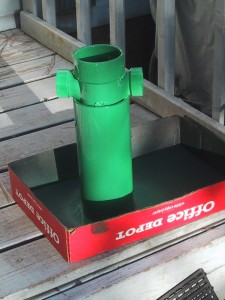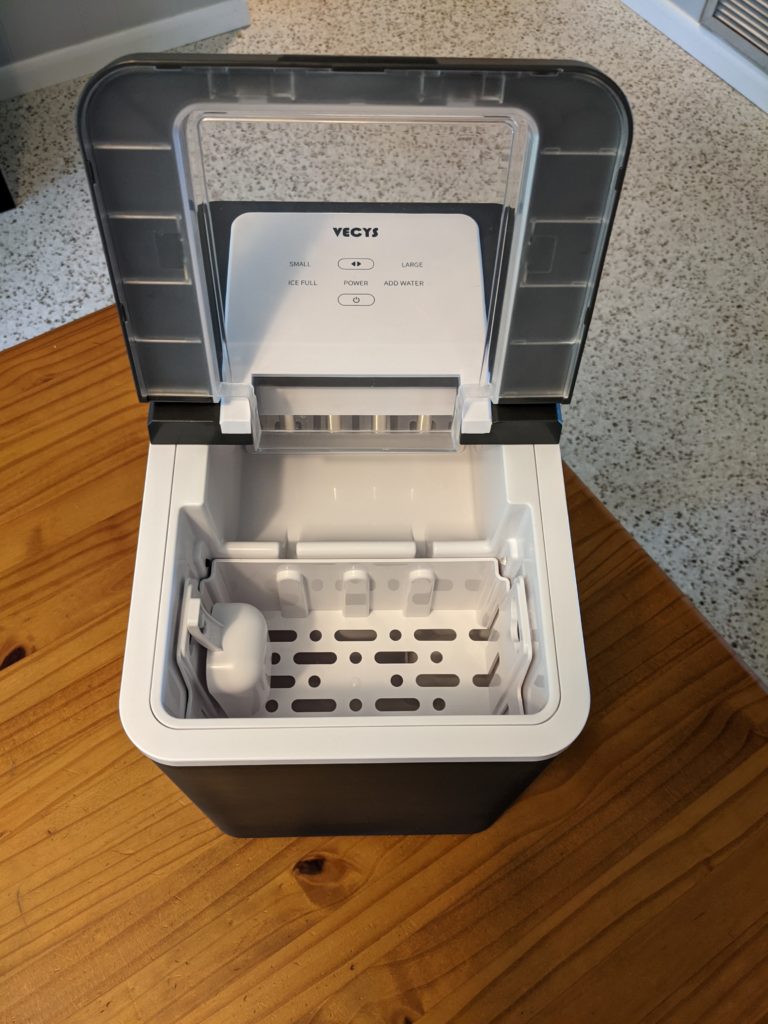While exploring alternate energy sources, I decided to try generating electricity by using the latent heat (or lack thereof) in Dry Ice, or solid CO2. The most direct (and solid state) way to generate electricity from a temperature differential is a peltier junction, which a 12V car cooler/heater unit happens to have. The pre-built cooler is also nice as it has a large aluminum bucket in the bottom to act as a heat sync for the dry ice, and a large heat-sink on the air side as well. (The mounting system for the peltier & heat-sink is very critical, so it was nice to find one pre-built.)
The latent heat (sublimation) of dry ice is 571,000 Joules per kilogram, so that's 571000 / 3600 = 158 Watt-Hours/Kilogram or 72 Wh/lb of energy. I measured 0.72A at 1.46V, or right at 1 watt of electricity coming out of the Peltier. (The power dropped slightly as the air heat-sink developed a coating of frost, which is a very good thermal insulator) If we assume the Peltier is around 5% efficient this gives us a thermal loss rate of around 20W/h, and the 6lb of dry ice should last around 20 hours. I didn't actually time it (as I was sleeping when it finished, and I hadn't set up a logging system on the power from the peltier) but I estimate that it lasted at least 12 hours (from the amount of dry ice left at the 10 hour mark), so it's likely that the cooler itself was leaking extra watts of thermal energy, or the peltier wasn't 5% efficient.
As Dry Ice is -109.3F (-78.5C, 194K) the maximum possible efficiency at room temp (70F, 294.15K), is 35%. Remember that Maximum Efficiency = 1 – (Tc / Th) (in Kelvin), or 1 – ( 194 / 294.15) = 1 – 0.65 = 0.35. An upside of dry ice is that as it is sublimating, you get the energy of both fusion and evaporation.
With Liquid Nitrogen (-320F (-196C, 77.15K) the maximum possible efficiency would be 74%. (And the latent heat energy is much greater!) 1 – ( 77.15 / 294.15 ) = 1 – 0.26 = 0.74 However, because Liquid Nitrogen is a liquid, you only get the energy of vaporization, which is 198.38 kJ/kg, less than dry ice. Also, Liquid Nitrogen is less dense than Dry Ice, so it would take more volume to hold a kilogram. So, unless you had a mechanism that more than doubled your actual efficiency, dry ice is better to store energy.
Of course, Liquid Nitrogen is much more difficult to contain and handle. A spill of dry ice in a relatively well ventilated area is not terribly dangerous, while a spill of liquid nitrogen could very easily lead to frostbite. CO2 is slightly toxic, while N2 is not, but the amount of CO2 generated by a few pounds of dry ice isn't a major problem unless you are trapped in an air-tight room with it.
Of course, a Lithium-Ion battery provides an energy density of 160 Wh/kg or 57.6kJ/kilogram (at 99.9% efficiency) With a 5% efficiency, dry ice only produces 29kJ/kg, (NOT counting the weight of the container, peltier junction, and insulation). I had aprox 2.7kg of dry ice, which produced possibly 1 watt for 12 hours (or 12 Wh/ 3 kg = 4 Wh/kg). This indicates that I wasn't getting anywhere near 5% conversion efficiency.
(In fact, it was closer to 158W/h / 4Wh = 2.53%) If we plug this back into the heat loss calculations I did earlier, it means that the dry ice was loosing a total of 1 Watt / 0.0253 = 39.5 W/h. It is possible that the peltier did have near a 5% efficiency, and that the additional 19 w/H loss was from the cooler. If this was true, the dry ice should have disappeared in 11 hours. Moral of the story: weight your dry ice carefully when you put it into your equipment (as opposed to when you buy it at the store), and record the total power output over time. (I'm only assuming that it kept up at the 1 Watt rate, frost buildup on the external heat sink could have lowered that.)






Hi, I saw this when researching, thank you for your work. Since 2007, sand batteries have become popular and I was going to do your experiment with a solar powered 500 F sand battery and CO2 or Dry Ice. This may be a large ask, but any equations to determine the wattage and voltage on thermocouplers for this scenario?
I believe the math is very similar, you just need the difference in temperature from the hot side to the cool side.